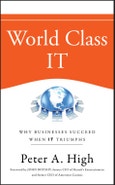World Class IT
Technology is all around us. It is so pervasive in our daily lives that we may not even recognize when we interact with it. Despite this fact, many companies have yet to leverage information technology as a strategic weapon.
What then is an information technology executive to do in order to raise the prominence of his or her department? In World Class IT, recognized expert in IT strategy Peter High reveals the essential principles IT executives must follow and the order in which they should follow them whether they are at the helm of a high-performing department or one in need of great improvement.
- Principle 1: Recruit, train, and retain World Class IT people
- Principle 2: Build and maintain a robust IT infrastructure
- Principle 3: Manage projects and portfolios effectively
- Principle 4: Ensure partnerships within the IT department and with the business
- Principle 5: Develop a collaborative relationship with external partners
The principles and associated subprinciples and metrics introduced in World Class IT have been used by IT and business executives alike at many Global 1000 companies to monitor and improve IT's performance. Those principles pertain as much to the leaders of IT as they do to those striving to emulate them.
Table of Contents
Foreword, by John Boushy xi
The Author xvii
Acknowledgments xix
Introduction xxi
1. IT and Broader Company Vision 1
2. Principle 1: Recruit, Train, and Retain World Class IT People 15
3. Principle 2: Build and Maintain a Robust IT Infrastructure 35
4. Principle 3: Manage Projects and Portfolios Effectively 59
5. Principle 4: Ensure Partnerships within the IT Department and with the Business 97
6. Principle 5: Develop a Collaborative Relationship with External Partners 119
Conclusion 143
Notes 147
Bibliography 151
Index 155








